2009 PRESS/PHOTO INFORMATION
The 2009 National Space Trophy was presented to former NASA Administrator Michael D. Griffin at a gala event on May 8, 2009 at the Houston Hyatt Regency. The presentation was made by RNASA Advisors, JSC Center Director Mike Coats, and Lockheed Martin Space Systems Company Vice President Ken Reightler. Stellar Awards were presented by current astronauts Sunita Williams and Leland Melvin. See the Agenda page for a complete list of speakers, and 2009 Winner page for a transcript of Griffin's speech and to read his profile as published in the program book.
Post Event Press Release. Note, 5-12 release amended 5-13 with one sentence added to the second paragraph (Congressman Pete Olson's proclamation) and 4 photos.
Mike Griffin Receives 2009 Rotary National Space Trophy
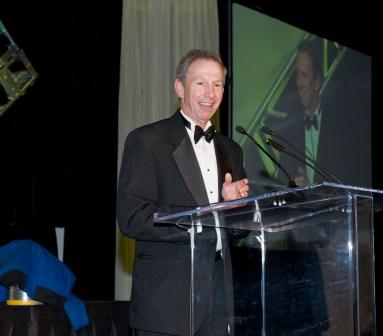
Mike Griffin. NASA photo. Click for a high resolution copy.
The Rotary National Award for Space Achievement (RNASA) Foundation's National Space Trophy was presented to former NASA Administrator Michael D. Griffin on Friday, May 8 at a gala held at the Houston Hyatt Regency hotel.
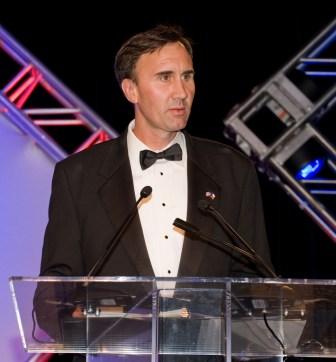
Congressman Pete Olson presents a certificate and letter. NASA photo. Click for a high resolution photo.
Guests, including former trophy winners, NASA officials, members of the military, aerospace executives, and Stellar Awards nominees, were welcomed by RNASA President Rodolfo González and Harris County Judge Ed Emmett. Congressman Pete Olson presented a proclamation congratulating RNASA on 23 years of recognizing space achievement.
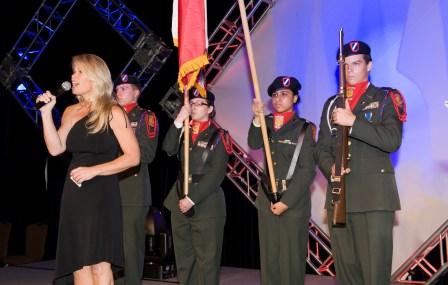
Clear Lake JROTC and soloist Kelly Williams. NASA photo. Click for a high resolution copy.
Clear Lake High School Army JROTC presented the colors, Kemah City Councilwoman Kelly Williams sang the anthem, and Greg Finke, senior pastor of Gloria Dei Lutheran Church in Houston, gave the invocation prior to a dinner featuring filet mignon with port wine reduction and jumbo crabmeat purse.
Veteran space correspondent Miles O'Brien served as emcee of the event and Space City Films wowed the audience with a multimedia production that included a congratulatory message from Senator John Cornyn, as well as a message from astronaut Mike Barrett on the International Space Station.
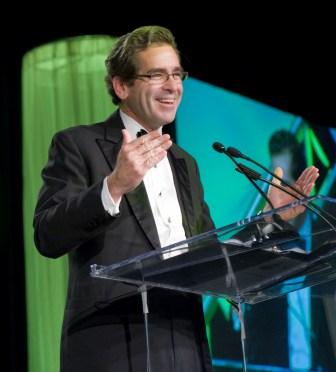
Miles O'Brien served as emcee. NASA photo. Click for a high resolution copy.
"On behalf of the crew," Barrett said, "I wanted to take a moment to offer our hearty congratulations to Mike Griffin, our former administrator, on his receipt of the 2009 National Space Trophy. It is an award honoring him for his leadership and vision that enabled NASA and the international partners to create this most magnificent engineering project here in orbit. Mike Griffin also provided the vision and courage NASA needed in a time of transition to our future work that will lead us away from low-earth orbit to explore other worlds. To you, Mike, all the best in your future pursuits; and to all the award nominees here present tonight as well for all of your inspirational work that allows us to live and work off the planet in the name of all mankind. As we near the 40th anniversary of humans' first landing on the Moon, let us celebrate our present accomplishments and our dreams for the future."
RNASA Advisors and former Space Shuttle astronauts Capt. Ken Reightler, now Vice President with Lockheed Martin; and Capt. Michael Coats, currently Director of Johnson Space Center, presented the trophy to Griffin. In keeping with Griffin's well known use of blunt language, the two provided a candid and humorous review of Griffin's resume' and historic quotes. After Reightler recounted Griffin's six degrees, Coats quipped, "Honestly, Michael, did all that education improve your golf game?"
Then, amid much laughter from the audience, Reightler recalled several of Griffin's most famous quotes, including one spoken to the Office of Management and Budget in a moment of great frustration; "Don't tell me how to build a spacecraft, I'm the chief engineer of the universe!"
As is customary at government retirement parties, Coats presented Griffin, his former boss, with a few humorous mementos. He also presented him with a NASA flight jacket that included patches from each of the organizations of the Johnson Space Center, and a NASA patch and American flag that were flown on STS-119. Coats noted, "The name tag also says, Michael D. Griffin, Chief Engineer of the Universe."
Turning more serious, Reightler and Coats then presented Griffin with the National Space Trophy which the audience approved with a standing ovation.
Accepting the trophy and appearing somewhat embarrassed by all the attention, Griffin said, "Now everyone will understand why I always said I really wanted to do this job [as NASA administrator] anonymously."
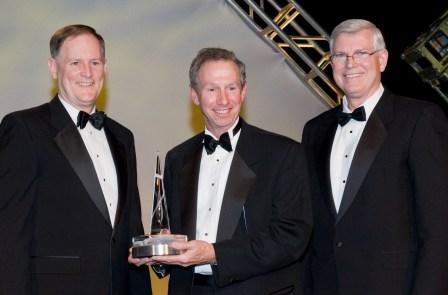
Mike Griffin receives National Space Trophy from Ken Reightler (left) and Mike Coats (right). NASA photo. Click for a high resolution copy.
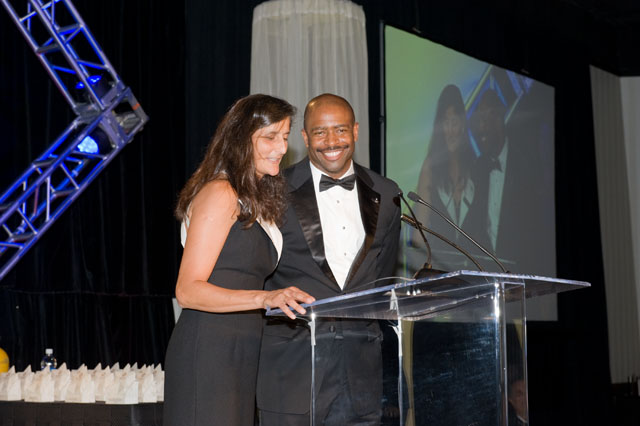
Astronauts Suni Williams and Leland Melvin. NASA photo.
Just prior to the trophy presentation, the RNASA Stellar Awards for individuals and teams had been presented by astronauts Leland Melvin and Captain Suni Williams. Griffin congratulated those winners, and predicted, "At least one or two of you are going to be up here some day trying to think of a speech."
He said the National Space Trophy was not an award he ever expected to receive. "But I'm very grateful for it and very honored to receive it, in this community especially, the home of human spaceflight." He thanked all the people who were on his team when he was administrator, "for making me look good. I didn't deserve it, but I appreciated it." He praised his former deputy administrator, Shana Dale, who was in attendance, and he also thanked all the people that had worked with him in the years past, including former National Space Trophy winners John Young, Glynn Lunney, Chris Kraft, and Gene Kranz.
"I really don't have the words to say how very much I enjoyed the opportunity to be your administrator; how enormously rewarding I found it. Yes, it fills up your life. It doesn't leave much room for keeping your golf game sharp … but it was a natural fit for me, and something that I enormously enjoyed." He noted that he didn't know who his replacement would be, but said, "I hope that whoever has it will find it within themselves to love the agency and our people and programs and our space enterprises as much as I do."
Remarking on the recently announced review of NASA by the Obama Administration, he said that reviews are essential to the conduct of technical enterprises, but that there are two kinds of reviews: one that looks at the progress being made; and the other that looks at what the goals should be. "When the review of the space program of the United States is reviewed, I think it will be found to be technically in solid shape-that it's being led by some of the best people we have in this nation-and yet it is starved for funding. The goals have to be brought into alignment with the funding. One can always change the goals, but I would heartily recommend against that. One could improve the funding. I would heartily recommend that we do that."
He said that a review of the goals themselves was the wrong kind of review. He praised the new strategic vision for the civil space program that was established and endorsed by the president and congress after the loss of the Space Shuttle Columbia. "That [vision] can live for generations." He emphasized that "the goals of the space program need to be stable on decadal time periods if the space community is ever to furnish anything in response to those goals. Even a discovery-class mission takes four to five years to accomplish if it's done well. We can't change the goals of the human spaceflight program of the United States every few years and ever expect to get a product."
Noting that Norman Augustine has been tapped to lead the review, Griffin said how much he admired Augustine's report, "Rising Above the Gathering Storm," that addressed how the United States is falling behind in higher education compared to other nations. He said "nothing would please me more than to see this latest review highlight the fact that the United States has coasted for 40 years on the lead purchased with the blood sweat and tears and money invested during the Apollo decade, and that it is time to reinvest if we want to maintain pre-eminence on the frontier."
He concluded by saying that "exploration is the hardest thing we do, but it is the engine which drives all else in society."
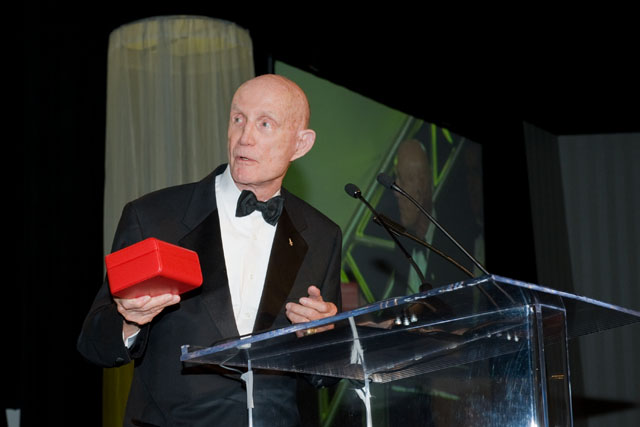
Lt. General Thomas Stafford presents an Omega watch. NASA photo.
Apollo astronaut Lieutenant General Thomas Stafford then presented Griffin with a special engraved watch on behalf of Omega Watches. Science Applications International Corporation sponsored an original portrait of Griffin by renowned aerospace artist Pat Rawlings that was unveiled at the event and graced the cover of the event's souvenir program book. It will be displayed with the original trophy at Space Center Houston.
A strong advocate for education, Griffin recently accepted a position as an eminent scholar in engineering and will serve as a professor of mechanical and aerospace engineering with the University of Alabama in Huntsville.
The event was sponsored by: The Aerospace Corporation, ARES Corporation, ATK Launch Systems, Ball Aerospace & Technologies Corp., Barrios Technology, Bastion Technologies, Beacon Associates, Inc., Blackhawk Management Corporation, The Boeing Company, Booz Allen Hamilton Inc., Cimarron, Draper Laboratories, GB Tech, Inc., General Dynamics, Hamilton Sundstrand, Honeywell, Jacobs Engineering, L-3 Communications, Lockheed Martin, ManTech SRS Technologies, Inc., MEI Technologies, Inc., MRI Technologies, National Space Biomedical Research Institute, Northrop Grumman Aerospace Systems, Oceaneering Space Systems, Omega Watches, Orbital Sciences Corporation, Pratt & Whitney Rocketdyne, Science Applications International Corporation (SAIC), SGT, Inc., Tech Trans International, United Space Alliance, University of Houston--Clear Lake, Wyle Laboratories, Inc.
The nonprofit Rotary National Award for Space Achievement (RNASA) Foundation was established by the Space Center Rotary Club of Houston in 1985 to organize and coordinate an annual Stellar Awards event to recognize outstanding achievements in space and create greater public awareness of the benefits of space exploration. For more information, visit http://www.rnasa.org.
----------2009 RNASA Stellar Awards Presented Press Release document. Text below:
2009 RNASA Stellar Awards Presented
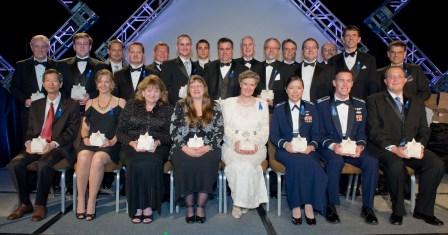
2009 Stellar Awards Winners. NASA photo. Click for a high resolution copy. Caption Front row L to R: Wen (late), Davidson (team), Webber (mid), Cline (late), Gale (late), Zhu (early), Knowlan (early), Hinerman (early). Back row L to R: ?Boyd (?team), Miller (early and team), Pilet (team), Window (team), McClain ((mid), Kirk (early), Harik (early), Mango ((mid), Sanzone (late), Frandson (late), Link (mid), Goldstein (mid and team), Cannon (late), Scoville (early), Steinetz (mid). Not pictured: Schrock. NOTE: Individual winner photos are available upon request.
Nearly a thousand people gathered on May 8 to honor former NASA Administrator Michael D. Griffin and Stellar Awards winners at a gala event hosted by the Rotary National Award for Space Achievement (RNASA) foundation at the Houston Hyatt Regency hotel.
Veteran space correspondent Miles O'Brien served as emcee of the event. RNASA advisors and former Space Shuttle astronauts Capt. Ken Reightler, now vice president with Lockheed Martin; and Capt. Michael Coats, currently director of Johnson Space Center, presented the trophy to Griffin.
In addition to the National Space Trophy, the RNASA Foundation presents Stellar Awards to outstanding individuals and teams each year.
NASA Astronauts Leland Melvin and Navy Captain Sunita Williams announced the winners and presented the RNASA Stellar Awards for 2009. "The Stellar Awards are important because they honor those who often work behind the scenes and whose careers and accomplishments may not be as visible as others," Williams said. "The breadth and scope of the nominees' work is truly amazing, and proof positive that we have a wealth of unusually bright and talented people who are working to ensure that the space program has a very promising future."
The Stellar Awards were presented in four categories: early-career, mid-career, late-career, and teams. The 2009 nominees included 103 individuals and 32 teams from the Department of Defense, 15 aerospace companies, and 6 NASA centers.
The nominations were evaluated by former National Associate Administrator for Space Systems Development, Arnold D. Aldrich, and former NASA Flight Directors and National Space Trophy winners, Drs. Christopher C. Kraft Jr. and Glynn S. Lunney who were in attendance at the banquet. The panel selected the winners based on which accomplishments hold the greatest promise for furthering future successes in space.
Melvin said, "It takes the dedication and the effort of thousands to get us into space, and these nominees represent the best of our best."
Each nominee was treated to a tour of Johnson Space Center and a luncheon at Bay Oaks Country Club that featured Skylab astronaut Col. Gerald C. Carr. Carr shared anecdotes from his mission and expressed his appreciation for the important work that the nominees perform in continuing the progress of the space program. "I'd love to go back into space and see our handiwork, but my wife won't let me," the 76-year-old astronaut joked. All nominees received certificates and signed copies of Carr's book, Around the World in 84 Days. The winners, announced at the evening banquet, also received marble trophies sponsored by ATK Launch Systems.
There were seven winners each in the early and middle career categories, six in the late career category, and five in the team category for 2009 as follows:
2009 Early Career Stellar Awards Winners
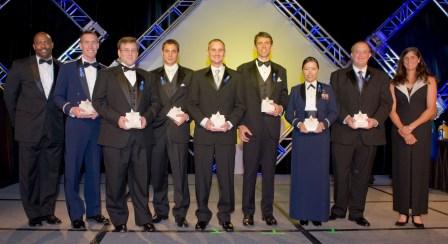
2009 Stellar Awards Winners in Early Career Category. NASA photo. Click for a high resolution copy. Caption L to R: Melvin (presenting), Knowlan, Miller, Harik, Kirk, Scoville, Zhu, Hinerman, and Williams (presenting).
Elliot P. Harik of The Boeing Company - Exceptional contributions, leadership and technical prowess in support of solar array rotary joint anomaly resolution for the International Space Station (ISS).
Timothy Hinerman of Pratt & Whitney Rocketdyne - Outstanding leadership in developing combustion stability analysis tools and applying them successfully to J-2X engine and attitude control thruster analysis.
Dr. Benjamin S. Kirk of NASA JSC- Outstanding technical contributions in determination of accurate aerothermal environments for safe operation of the Space Shuttle orbiter and development of the Orion spacecraft.
Capt. Garrett W. Knowlan of the USAF - Exceptional contributions to space-based global navigation leading to a common global positioning system (GPS)-Galileo signal for civilian use between the United States and Europe, the next generation GPS civil signal design for an expected 1 billion users, and a 25 percent increase in GPS military signal power to the warfighter.
Timothy M. Miller of MEI Technologies, Inc. - Outstanding contributions to far-infrared ground-based astronomy through development, fabrication, and assembly of a novel infrared detector, and technology development of highly sensitive large-format arrays for future observing missions.
Zebulon L. Scoville of NASA JSC - Superior technical contributions and leadership in the area of extravehicular activity (EVA) during the most dynamic period in EVA history.
Capt. Bai L Zhu of the USAF - Outstanding contributions as an evolved expendable launch vehicles responsible engineer, leading mission assurance and anomaly resolution efforts to restore the United States' heavy launch capability and to drive process and safety improvements.
2009 Middle Career Stellar Awards Winners
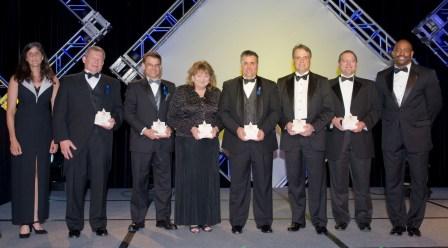
2009 Stellar Awards Winners in Middle Career Category. NASA photo. Click for a high resolution copy. Photo caption L to R: Williams (presenting), McClain, Steinetz, Webber, Mango, Link, Goldstein, and Melvin (presenting). Schrock not pictured.
Barry G. Goldstein of NASA Jet Propulsion Laboratory - Outstanding contributions as the Phoenix Project manager, leading to the successful Mars landing followed by unprecedented scientific findings from the North Polar Region of Mars.
Dwight E. "Chip" Link Jr. of The Boeing Company - Outstanding sustained contributions in fluid system and life support system design and integration for the ISS program.
Edward J. Mango of NASA Kennedy Space Center - Exceptional leadership, dedication, and technical expertise in understanding and resolving the Engine Cutoff Sensor anomaly and enabling the Space Shuttle program to continue its mission to safely complete ISS assembly.
Terrell A. McClain of The Boeing Company - Lifelong dedication to the design of the backup flight system, and personal commitment to astronaut safety during all Space Shuttle missions.
Mark B. Schrock of United Space Alliance - Outstanding design and development of innovative proximity operations techniques required to support the Space Shuttle program.
Dr. Bruce M. Steinetz of NASA Glenn Research Center - Exceptional technical contributions in aerospace seals research and development and leadership of an internationally recognized NASA Seals team.
Carol L Webber of Lockheed Martin - Exemplary achievement in leading the Orion Composite Crew Cabin trade study to a consensus recommendation and securing a prompt decision from the administrator of NASA.
2009 Late Career Stellar Awards Winners
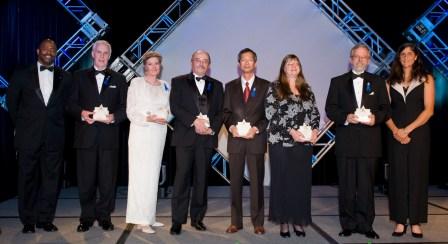
2009 Stellar Awards Winners in Late Career Category. NASA photo. Click for a high resolution copy. Photo caption L to R: Melvin (presenting), Sanzone, Gale, Cannon, Wen, Cline, Frandsen, and Williams (presenting).
Scott A. Cannon of ATK Launch Systems - Vision, leadership and technical excellence in executing of the complex task of guiding multiple organizations to a successful Ares I first stage Preliminary Design Review milestone.
Lynn F. H. Cline of NASA Headquarters - Exceptional contributions to the global community through realized human and robotic partnerships and discoveries in space.
Jon D. Frandsen of Pratt & Whitney Rocketdyne - Exceptional materials and processes technical expertise and leadership to the Space Shuttle main engine in support of flight safety.
Anita E. Gale of The Boeing Company - Relentless pursuit of more cost-effective cargo integration approaches, reducing both time and budget required to integrate payloads and vehicles and to deliver payloads to orbit.
Thomas V. Sanzone of Hamilton Sundstrand - Exceptional contributions to EVA during a 40-plus year career, from the first human on the moon to current preparations for a return to the moon, Mars and beyond.
Dr. Yiting Wen of MEI Technologies, Inc. - Exceptional contributions to the development and characterization of advanced detector systems for NASA's science missions.
2009 Team Stellar Awards Winners
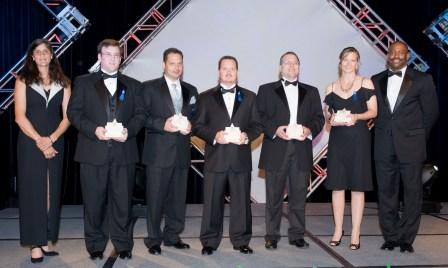
2009 Stellar Awards Winners in Team Category. NASA photo. Click for a high resolution copy. Photo caption L to R: Williams (presenting), Miller (Low-Density Parity Check Team of MEI Technologies, Inc.), Pilet (External Tank Engine Cut-Off System Redesign and Certification of Lockheed Martin), Window (ISS Solar Alpha Rotary Joint Recovery Team of NASA JSC), Goldstein (Phoenix Project Team of NASA JPL), Davidson (ISS Joint Station Local Area Network Team of The Boeing Company), and Melvin (presenting).
External Tank Engine Cut-Off System Redesign and Certification of Lockheed Martin - Technical excellence and outstanding team dedication in identifying the external tank engine cut-off system anomaly root cause and expeditiously redesigning and verifying a critical system. Mr. Jeffrey C. Pilet accepted for the team.
ISS Joint Station Local Area Network (LAN) Team of The Boeing Company - Successful design, development, integration, testing and on orbit deployment of the ISS joint station LAN that provides a high speed, low cost, Ethernet network for both operational and payload use throughout ISS, including both U.S. and International Partner modules. Suzanne R. Davidson accepted on behalf of the team.
ISS Solar Alpha Rotary Joint Recovery Team of NASA JSC- Exemplary performance in determining the root cause of the ISS Solar alpha rotary joint anomaly and implementing required measures to resolve the issue. Kevin N. Window accepted on behalf of the team.
Low-Density Parity Check Team of MEI Technologies, Inc. - Outstanding contributions to developing enabling technologies and providing solutions to challenging technical problems of increasing the high-speed downlink rate in satellite communications. Sam Boyd accepted on behalf of the team.
Phoenix Project Team of NASA Jet Propulsion Laboratory - Outstanding technical excellence and team dedication enabling another first for the United States space program by the successful polar mission around another celestial body. Barry G. Goldstein accepted on behalf of the team.
Stellar winner photos will be posted on the Stellar Winners page as soona s they are available.
The event was sponsored by: The Aerospace Corporation, ARES Corporation, ATK Launch Systems, Ball Aerospace & Technologies Corp., Barrios Technology, Bastion Technologies, Beacon Associates, Inc., Blackhawk Management Corporation, The Boeing Company, Booz Allen Hamilton Inc., Cimarron, Draper Laboratories, GB Tech, Inc., General Dynamics, Hamilton Sundstrand, Honeywell, Jacobs Engineering, L-3 Communications, Lockheed Martin, ManTech SRS Technologies, Inc., MEI Technologies, Inc., MRI Technologies, National Space Biomedical Research Institute, Northrop Grumman Aerospace Systems, Oceaneering Space Systems, Omega Watches, Orbital Sciences Corporation, Pratt & Whitney Rocketdyne, Science Applications International Corporation (SAIC), SGT, Inc., Tech Trans International, United Space Alliance, University of Houston--Clear Lake, Wyle Laboratories, Inc.
The nonprofit Rotary National Award for Space Achievement (RNASA) Foundation was established by the Space Center Rotary Club of Houston in 1985 to organize and coordinate an annual Stellar Awards event to recognize outstanding achievements in space and create greater public awareness of the benefits of space exploration.
------------
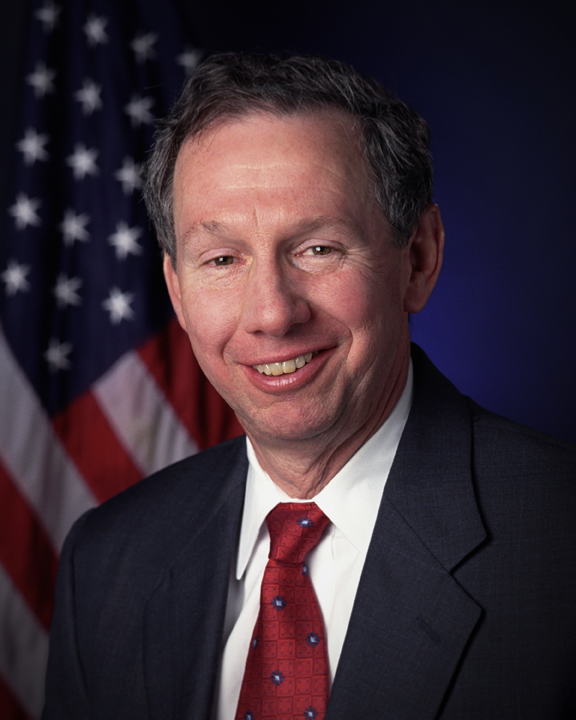
Michael Douglas Griffin
Click for a high resolution photo (300 dpi at 8x10 size). Alternative high resolution (300 dpi photo at 5x7 size) photo.
Read press release Word document, or pdf. Here is a Word document of Griffin's Biography separately from the press release.
Griffin was selected for the National Space Trophy for: developing the plan for completion of the International Space Station following the loss of Space Shuttle Columbia, personally directing the shuttle return-to-flight activities; initiating the first procurement of commercial cargo and crew service in the agency's history; successfully establishing the architecture for a sustainable, achievable, and technically viable human exploration program; and awarding the initial spacecraft and launch vehicle contracts that will ensure the program meets its demanding schedule.
Griffin is also being recognized for the impressive series of senior government and industry executive positions he held prior to being named NASA administrator. These positions include Space Department head of the Johns Hopkins University Applied Physics Lab where he oversaw and directly supervised the final preparation, launch, and early mission operations for the MESSENGER spacecraft to Mercury; president and COO of In-Q-Tel, where he led a private non-profit, strategic venture capital organization created to identify and develop advanced technologies for Central Intelligence Agency applications; and executive positions with Orbital Sciences Corporation, Space Industries International, and American Rocket Company; service as the NASA chief engineer and associate administrator for Exploration; and the deputy for technology for the Department of Defense's Strategic Defense Initiative Organization (SDIO).
A strong advocate for education, Griffin holds six postgraduate degrees and has served as an adjunct professor and lecturer at three different universities. He is also the lead author for more than two dozen technical papers as well as writing the definitive textbook on space vehicle design.
Former Apollo astronaut and 2008 Trophy winner Capt. Eugene Cernan said, "Mike Griffin has made an enormous contribution to the American Space Program throughout his career as a scientist, engineer, and manager. Few people understand the challenges and rewards of spaceflight like he does. Mike has been a visionary, but with a realistic and pragmatic approach to the challenges he has faced. Above all, Mike Griffin recognizes the positive educational impact of our nation's space program on the youth of America."
RNASA Advisor and former Space Shuttle astronaut Capt. Ken Reightler added, "Mike Griffin is one of those rare individuals who is not afraid to tackle even the most difficult engineering and management issues, such as those NASA has faced while implementing the U.S. Space Exploration Policy and during the return-to-flight activities after the Columbia accident.
Griffin will receive his trophy at the RNASA annual black-tie banquet to be held on Friday, May 8, 2009, at the Hyatt Regency Houston. Veteran space correspondent Miles O'Brien will serve as Master of Ceremonies.
The nonprofit Rotary National Award for Space Achievement (RNASA) Foundation was established by the Space Center Rotary Club of Houston in 1985 to organize and coordinate an annual Stellar Awards event to recognize outstanding achievements in space and create greater public awareness of the benefits of space exploration.
Griffin's biography is posted on the Trophy Winner page.
Speakers for the banquet are listed on the Agenda page.
Information on the Stellar Awards is available through the Stellar Awards page, with photos and citations of previous winners on the Stellar Winners section of the Stellar Awards page.
